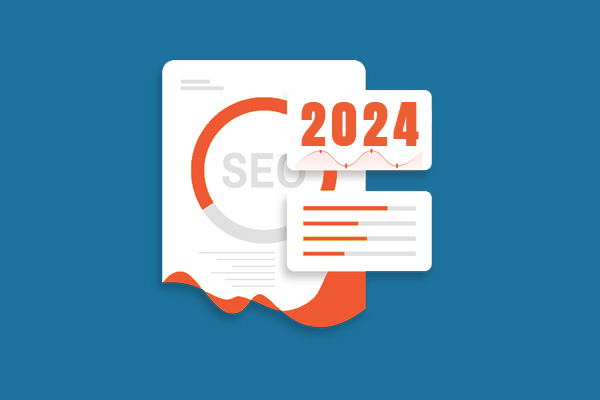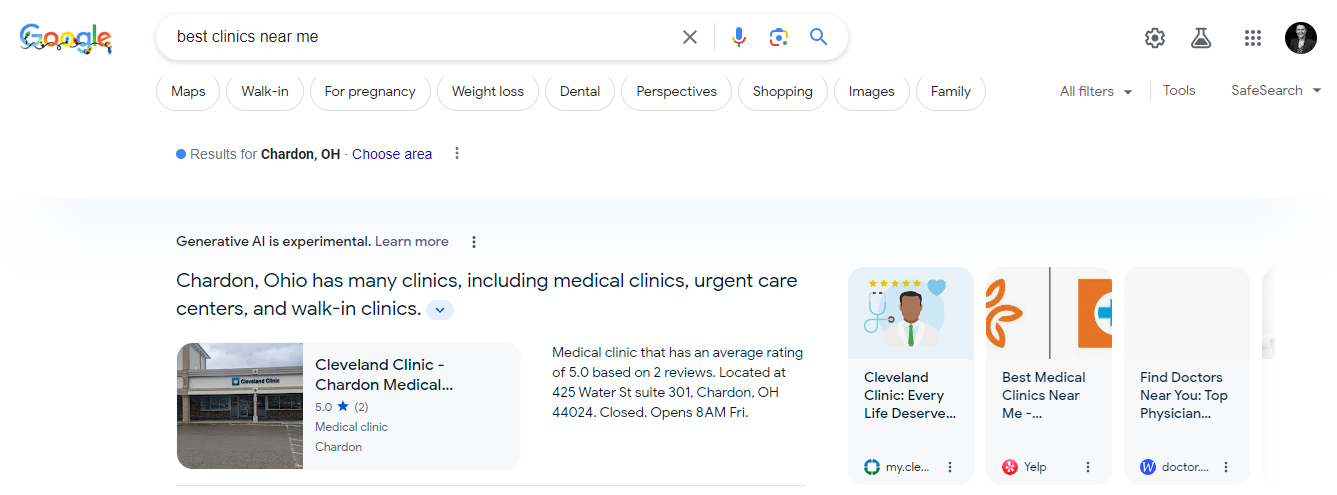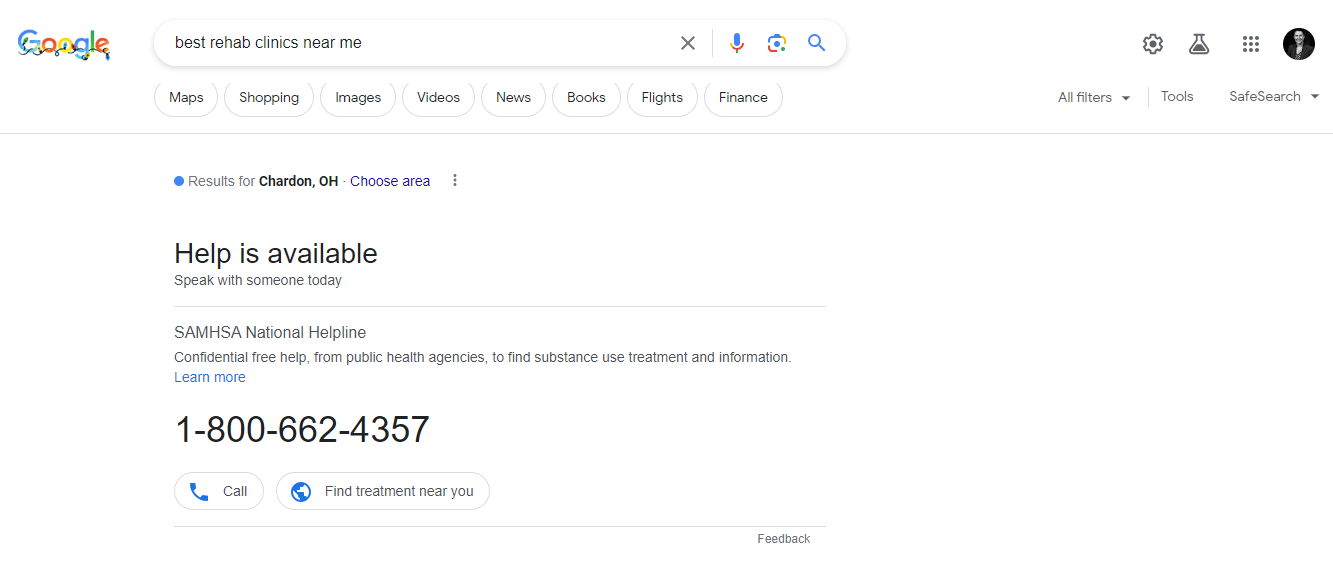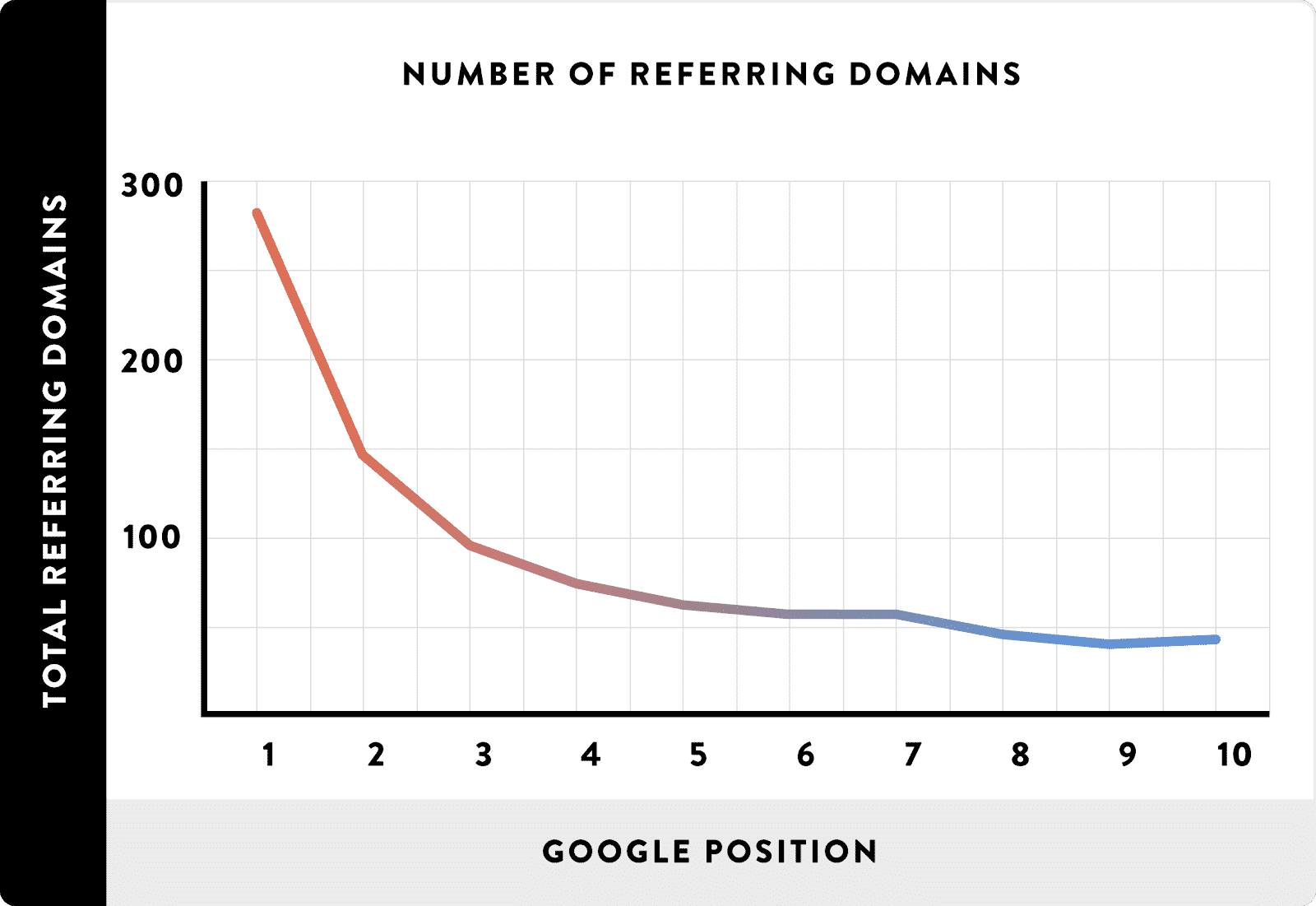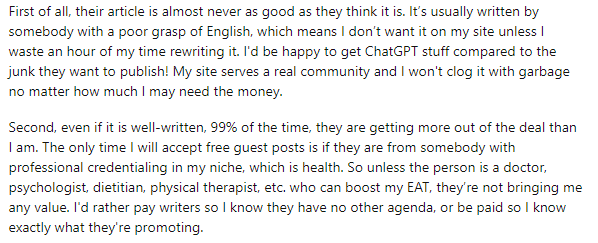You don’t need me to tell you that SEO looks different these days.
Artificial intelligence and Google core updates have made marketing your drug rehab center more complex and challenging.
In a post-HCU world (Helpful Content Update) and Search Generative Experience (SGE), your business needs to adapt to the rapidly evolving digital landscape.
Worry not!
This 2024 best practice SEO guide for drug rehabs will prepare you for the coming changes in 2024 and beyond.
In 2024, the best SEO strategy for drug rehab centers includes:
- Competitor Analysis
- Keyword Research
- Helpful Content
- Local SEO (Google Business Profile)
- Technical SEO
- On-Page Optimization
- Off-Page Optimization
- Page Speed Optimization
- Link Building
- User Experience
- Tracking and Analytics
This comprehensive guide walks through everything I’ve learned about building SEO for addiction treatment centers. In addition to outlining each of the steps, I explain the nitty-gritty SEO process so you know what to expect.
Let’s dive in.
What is SEO?SEO stands for (Search Engine Optimization), which is the process of boosting your website’s visibility on a variety of search engines (usually Google). For addiction treatment centers, this includes building your online authority through great content, quality backlinks, and an intuitive site structure. The guide below explains what you need to perform drug rehab SEO effectively. |
|---|
The Best Drug Rehab SEO Strategy of 2024
SEO isn’t rocket science.
But if you own a rehab center, it does require a lot of work.
Because there are hundreds of drug rehab centers and treatment aggregator sites lobbying for the same first-page Google rankings you are. Many of them have a significant head start, too.
Thankfully, you have everything it takes to catch up.
I packed this guide full of the most valuable drug rehab SEO techniques that still work in 2024. I also covered topics like AI, SGE, and HCU so your business can get and stay ahead for a long time.
If you want to start competing with the big rehab brands, this is the guide for you.
Let’s get started.
1. Competitor Analysis
Knowing how and where your competitors show up is the first step in building an SEO strategy.
You can do this in one of two ways:
- Look at your local SEO map pack and Google search results. I Googled ‘drug rehabs in Florida’ and got the following results:
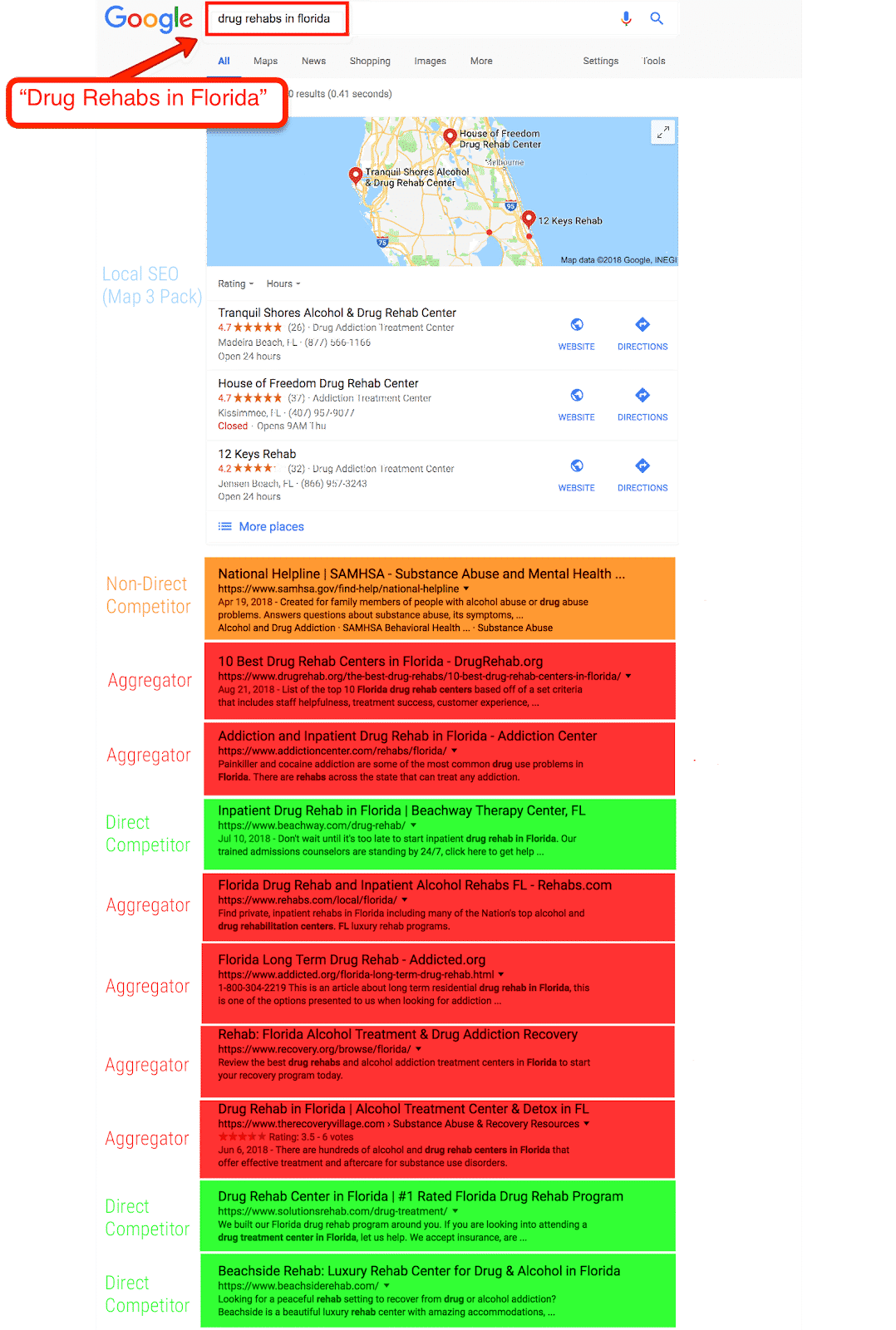
- Use a tool like Ahrefs or SEMrush to look at your competitors at a glance. Here’s what I got by running a comparison on Transformations By The Gulf on Ahrefs:
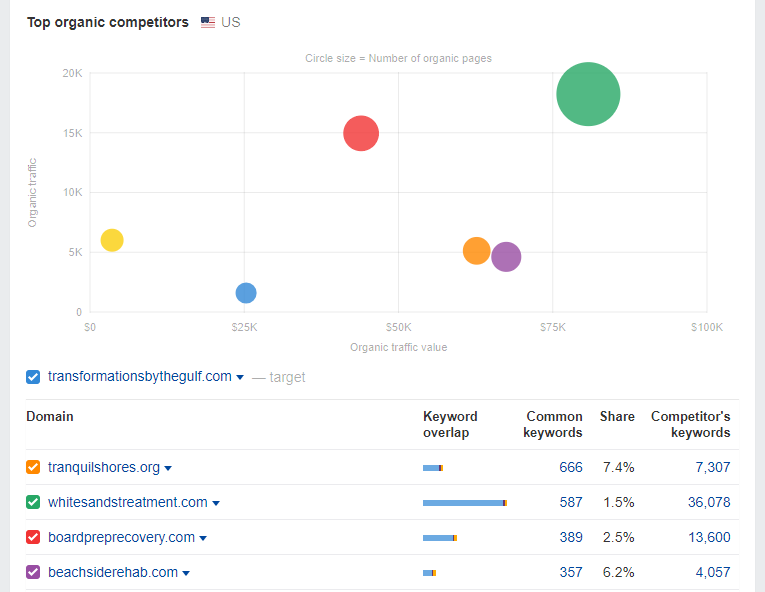
3. You can also use select AI tools to make a list of competitors. First, prompt your AI of choice to make a list based on your URL. Then, look through each of the recommendations and verify them as true competitors. Remember: AI isn’t perfect.

Whichever option you choose, make a list of 10 competitors in an Excel sheet.
If you want to compete in the addiction SEO space, this first step is crucial.
2. Keyword Research
This is where you identify keywords patients can use to find your services.
Thankfully, it’s a relatively simple process. It’s also much easier with the help of AI.
Let’s say you have a rehab center in Las Vegas and want to improve your organic search presence.
Here are the micro steps you should take:
Step A: Validate the Keywords
Remember that list of 10 competitors from earlier? Now it’s time to dig a little deeper.
You can use a tool like SEMrush to find their highest-performing content. Here’s an example of some pages below:
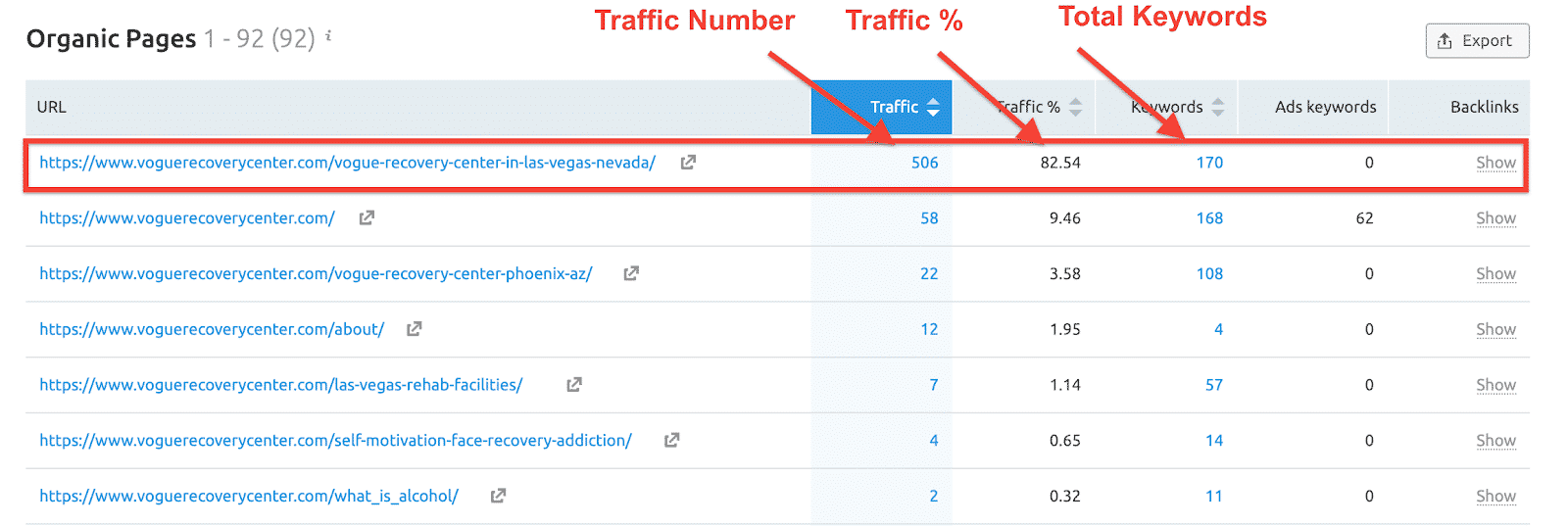
Take a look at each ranking page and make a note of their attributes. What type of content is it? How long is it? Are there custom graphics or videos?
Add all this information to your Excel sheet.
Now, we’re going to dig deeper into their keywords and identify which ones bring the most value to the page. Many of them will be longer keywords with higher purchasing intent.
The moment you figure out what keywords drive the most organic traffic, you can directly apply them into your content strategy.
Keep in mind 70% of all searches on Google consist of more than three words. This means optimizing your page with ‘long-tail’ keywords lets you hit three birds with one stone:
- Less competition
- Higher conversion rates
- Targeted traffic
At this point, you can add some of these keywords (and their page characteristics) to your Excel sheet. Then, you can proceed to the next step.
Step B: Domain Authority And Keyword Competition

All rehab sites have something called Domain Authority, which is a measure of how many backlinks they have (and therefore how authoritative they are on specific topics).
The higher a website’s DA is, the harder it will be to outrank them.
| Domain Authority | Competition |
|---|---|
| DA 1 to 19 | Low |
| DA 20 to 39 | Medium |
| DA 40+ | High |
Keywords also have a difficulty score, which most online tools express as a percentage. The higher the percentage is, the harder it is to rank for that keyword.
Here’s a basic chart for guidance:
| Keyword Difficulty | Competition |
|---|---|
| KD 1 to 39 | Low |
| KD 40 to 59 | Medium |
| KD 60+ | High |
Every SEO platform uses a different algorithm to calculate this, so I highly suggest using two or more tools to create a working average.
Any keyword ranked at 39 or less may be a good candidate for your SEO strategy. Add the competition of each keyword to your Excel sheet and then move to the next step.
Step C: Check Search Results
Using your Excel sheet as a reference, search a selected keyword on Google. Then, note the total number of search results underneath the search bar.

The fewer search results there are, the lower your competition will be. The search we did above shows the keyword ‘rehab facilities las vegas’ is an excellent candidate.
| Total Search Results on Google | Competition |
|---|---|
| 1 to 30 Million | Low |
| 30 to 60 Million | Medium |
| 60 to 100 Million+ | High |
Update your spreadsheet with this information and proceed to the final step.
Step D: Putting It All Together
By now, you should have an Excel spreadsheet that looks something like this:
| Keyword | Domain Authority | Keyword difficulty Score | Total Search Results on Google | Content Types | Content Length | Custom Graphics/ Videos |
|---|---|---|---|---|---|---|
| Rehab facilities in Las Vegas | 27/100 | 60/100 | 2,770,000 Results | Inner Page | 200 | Yes |
| Las Vegas Treatment Center | 35/100 | 56/100 | 58,900,000 Results | Home Page | 10K+ | Yes |
| Drug Rehab Las Vegas | 35/100 | 60/100 | 7,690,000 Results | Inner Page | 200 | Yes |
This gives us a birds’ eye view of the most valuable keywords that are easy to rank.
As you can see, there are no easy pickings in this highly competitive vertical.
But with a little planning beforehand, you can easily figure out which type of content is dominating, then pick the best word count, visuals, and content gaps so you can do more with your content and get ahead of the curve.
I’ve personally applied this keyword process to our own blog at 12SM Agency. As you can see, traffic is steadily growing:

3. Helpful Content
Google released its Helpful Content Update in September 2023. This had a major impact on many sites, tanking traffic by as much as 50%.
So what does this mean for drug rehab SEO?
Writing truly helpful content matters more than ever.
Here’s what I recommend from start to finish.
Content Structure
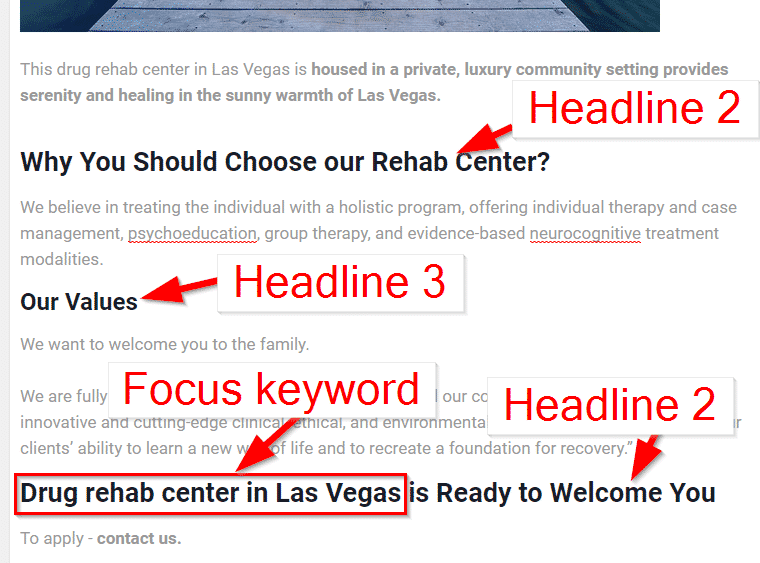
- Each page should have only one H1 headline.
- Sub-headings should be heading 2, sub-sub-headings should be heading 3, and so on.
- It’s a good idea to include a focus keyword in one of the headlines and a few synonyms.
Content Imagery
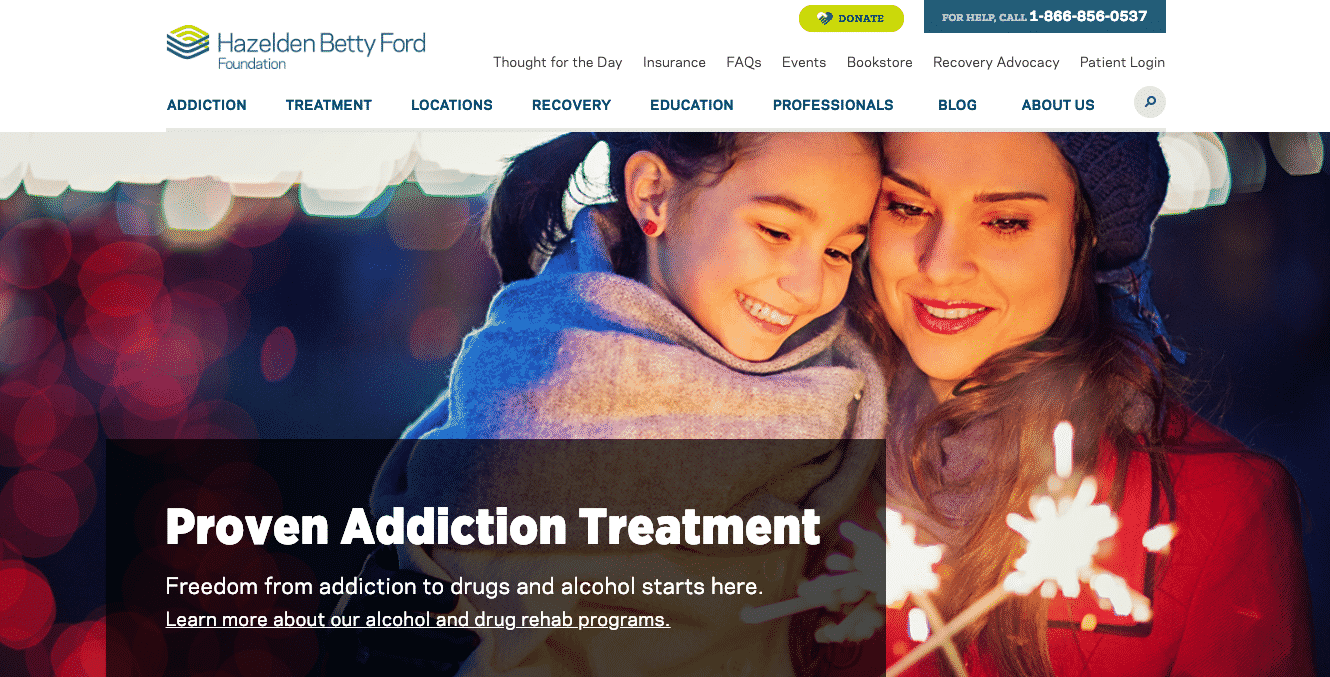
- Avoid stock photography and use real photos, custom graphics, or quotes whenever possible.
- Split A/B test your hero image to see which results in higher conversion.
- Compress large images or use third-party media hosting services.
Sidenote: you may want to be careful about using AI images, as tempting as it can be.
You could hit on something halfway decent. . .
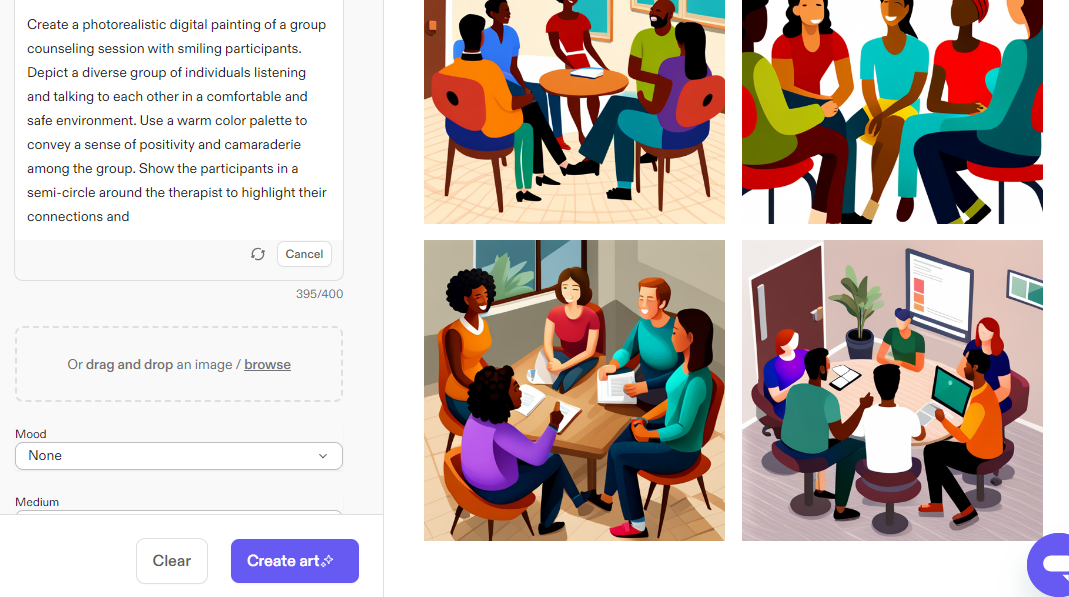
. . . or you might strike out with something a little less relatable.

As always, your mileage may vary. But be sure to think twice before uploading any old image.
Content Depth, Length, And Angle
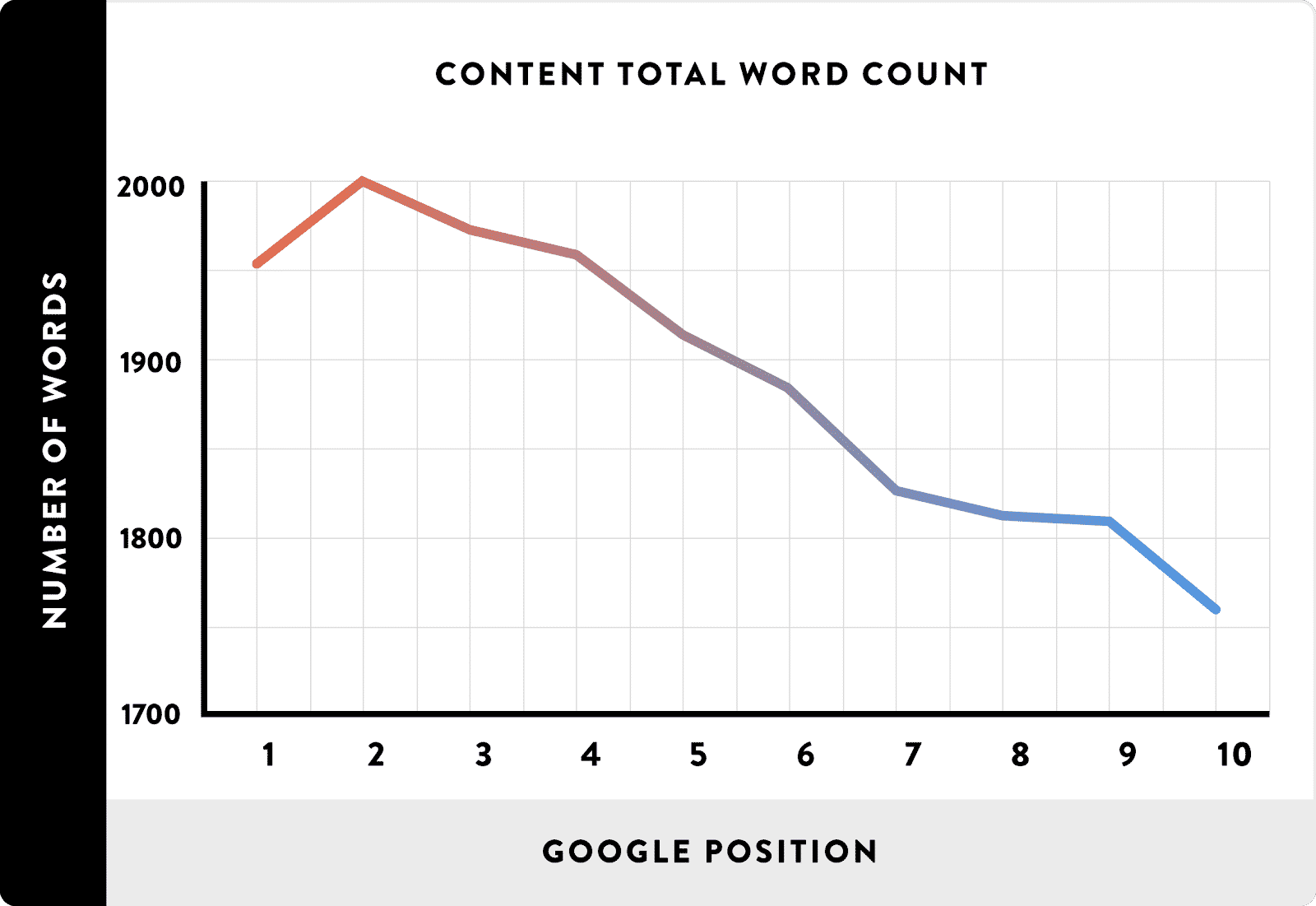
- Create content for each stage of the buyer’s journey: TOFU, MOFU, and BOFU. You could also use micro-moments to deliver on searcher’s needs.
- The average word count of a Google first page result is 1,890 words. But don’t write 2,000 word posts just to make the first page. Quality still counts.
- A good rule of thumb is to include hyperlinks (internal or external) for every 120–200 words to create a healthy internal link structure.
You should also try to think through value-adds that make your content stand out from the crowd.
Could you offer better time-to-value? Screenshots or images not found anywhere else? Comparison tables or charts your competitors have yet to provide?
Missing links could provide you with a huge opportunity.
Content Keywords
The content you write should have a strong backbone of support from both keywords and LSIs.
I recommend:
- Using well-vetted keywords identified from step two of the SEO process
- Leaning on ‘People Also Asked’ or Answer The Public to find related topics
- Avoiding keyword stuffing at all times (unless you want to tank your content)
You can also use AI to identify keyword gaps after you’ve published your content.
First, pull up Originality.ai on a free or paid plan:
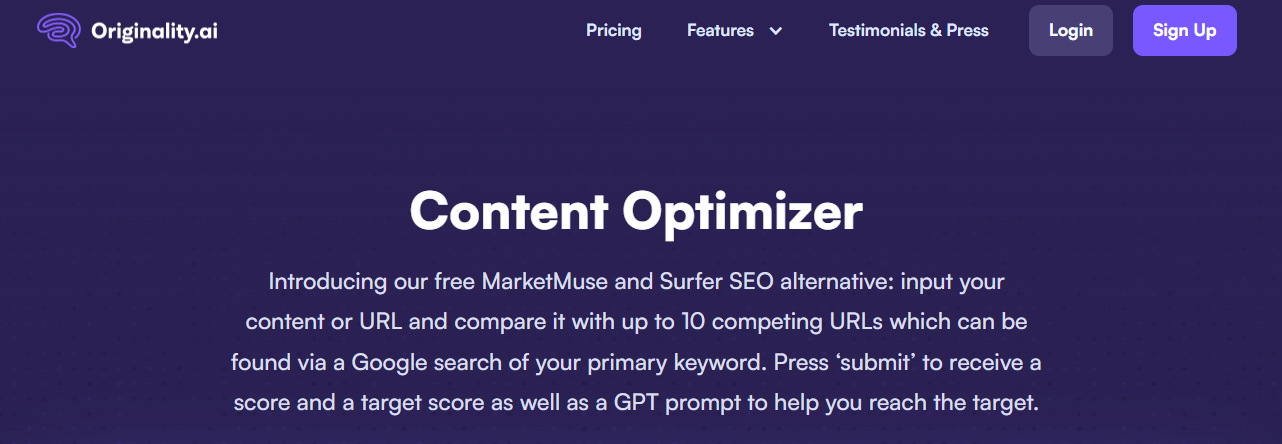
Then, enter the URL of your content, your primary keyword, and the URLs of 10 competitors.
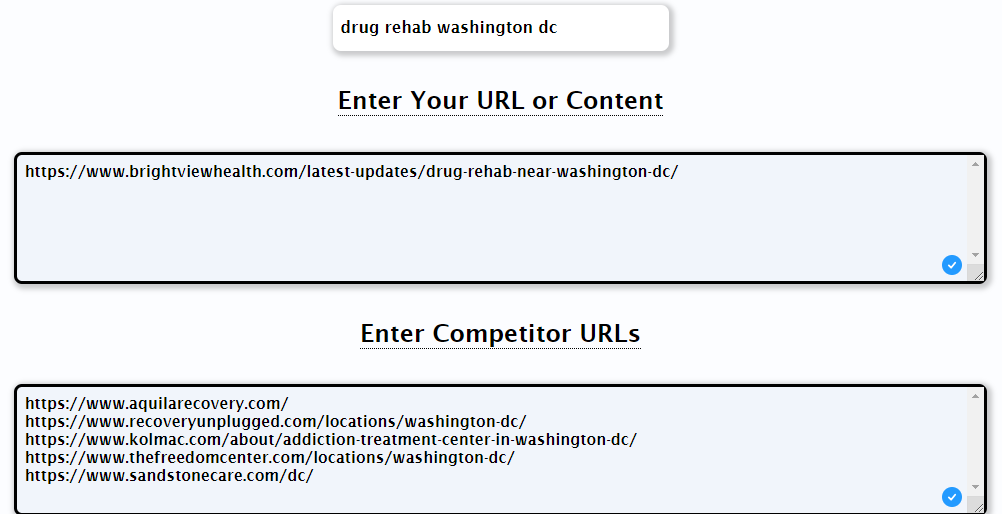
Tap submit at the bottom of the page to generate your results.
You should receive some interesting insights to consider, including a comparison of your score versus your competitors’ score. Looks like there’s some room for improvement here:

You also get a comprehensive list of keywords to increase or decrease in your content.
For this rehab clinic, Originality AI suggests removing three instances of the word ‘addiction’ and adding one instance of the word ‘health.’
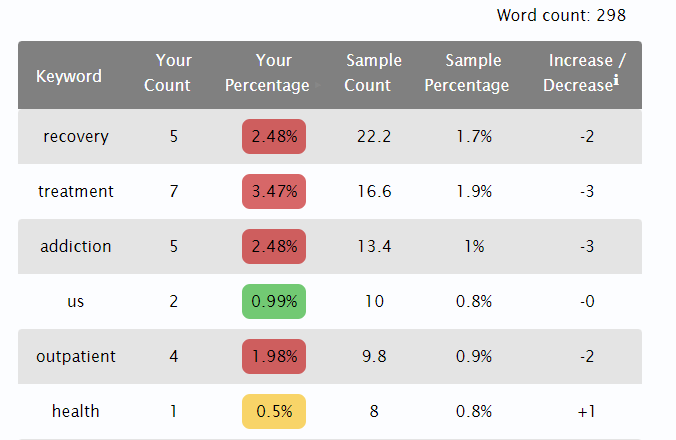
You can also download a CSV of your keywords, export a GPT prompt, or highlight keywords in the text stripped from your submitted URL.
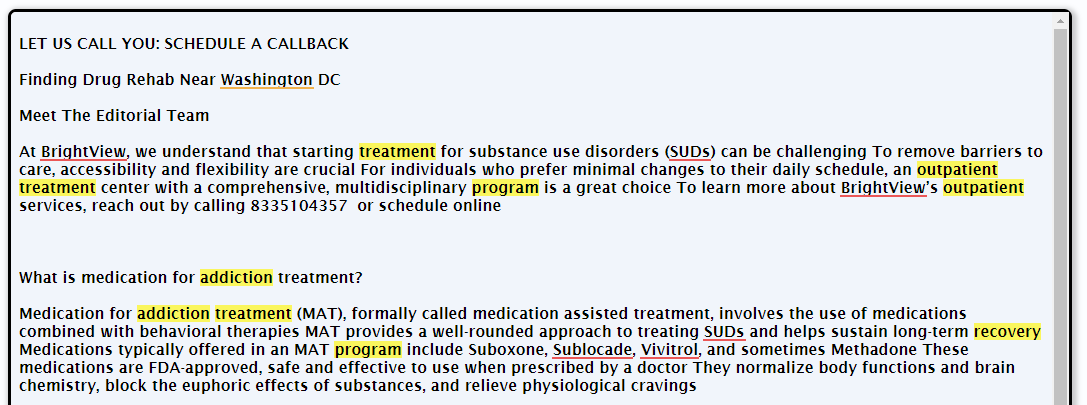
Content Generation (Generative AI)
You can use a multitude of AI tools to generate content for your business.
But not all tools are created alike — and AI alone isn’t likely to boost your rankings.
Let’s take a look at the Hotjar SEO experiment, which is a recent study concluded in December 2023. The company pitted a human writer against ChatGPT, and the human won out in all SEO categories.
Their comparison chart speaks volumes:

That’s not to say AI is useless, however. There’s a lot you can do with the help of AI.
When it comes to content generation, I recommend using it to:
- Write FAQ sections
- Build articles from transcripts
- Create outlines for future writers
- Developing boilerplates to tinker with in the future
- Summarize long-form content into smaller chunks
Don’t expect to generate an AI article without a keen eye for quality control.
The Bottom Line
TL;DR: Before you start writing your content, you should know exactly what keywords, content, and components are missing from your competitor’s content.
Consider all this and more before publishing any articles.
A Word About Search Generative Experiences (SGE)Google released its Search Generative Experiences tool (SGE) on May 10, 2023. This was designed to help users find answers without clicking into specific webpages. SGE hasn’t impacted the drug rehab space too heavily, since searches of this nature are considered sensitive by Google. Check out this search for ‘best clinics near me’:
Now look what happens if I search ‘best rehab clinics near me’:
As you can see, there’s no SGE answer available. Yet. Remember: SGE pulls relevant snippets from the top two organic results for any query. This means ranking in position one for specific keywords can help you reach searchers regardless of generative AI. To get ahead of the curve, I recommend:
|
|---|
4. Local SEO (Google Business Profile)
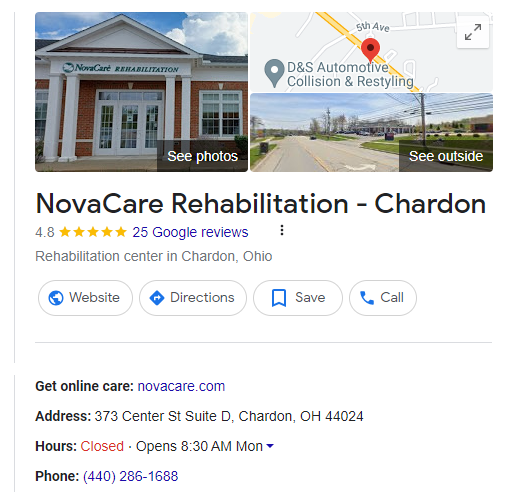
Your Google My Business profile is one of the most powerful tools at your disposal.
Not only can you rank higher just by updating your profile, but you can also become more competitive in the map pack, which makes potential searchers more likely to call your business first.
If you haven’t already made a GMB account, I highly suggest going through the process with Google. Expect to jump through a few hoops to verify your business.
Next, update your GMB page with the following information:
- Your address, hours, and phone number (which should match what you have on your website)
- Your website URL and social media profiles
- Pictures and images associated with your business (just keep HIPAA in mind)
- An ‘about us’ section listing what you do and who you serve
- Contact information, booking details, or insurance information
You may want to go the extra mile with regular GMB posts. While they can positively affect your drug rehab SEO, they definitely can’t do all the work on their own.
Think of it as the cherry on top for a far more holistic SEO strategy.
5. Technical SEO
Technical SEO is all about structuring your content to make sense to both humans and robots.
Thankfully, it’s not all that complicated.
I suggest taking it step by step:
Submitting Your Sitemap To Google
A sitemap helps Google understand what your site is about. You can also create sitemaps for videos, images, and news content (depending on what your rehab center offers).
Google clearly states that not everyone needs a sitemap. If you have less than 500 pages and not a lot of rich media, it’s probably not as important. But if you have thousands of pages, are relatively new, or have lots of rich media, it may be a good idea.
You can build out your sitemap in a few different ways. Here’s a breakdown of all three:
| Sitemap Options | Pros | Cons |
|---|---|---|
| XML Sitemap |
|
|
| RSS, mRSS, and Atom 1.0 |
|
|
| Text Sitemap |
|
|
For drug rehab SEO, I recommend using a free generator like XML Sitemaps.
There are also a few AI tools you can use:
Creating An SEO-Friendly Site Structure
As I mentioned earlier, Google likes a well-organized site.
You should only have one H1 per page.
Any headings after that should be H2s, and subheadings under that should be H3s.
It’s really as simple as that.
But you should also be on the lookout for other problems affecting SEO, especially:
- Orphan pages (pages with no incoming links)
- Non-canonical pages in your sitemap (which give conflicting signals to Google)
- Double slashes in URLs (which can sometimes lead to duplicate content)
Speaking of duplicate content…
Finding And Fixing Duplicate Content Issues
If you have Ahrefs, this should be a very simple fix.
First, add your site’s URL as a project in Ahrefs. The setup wizard should walk you through this.
Allow Ahrefs to perform a website audit. Then, look at the health score of your site. You can click it to read more about the final audit.
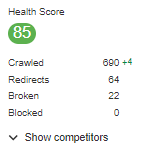
Then, navigate to the ‘duplicates’ tag to get more information on duplicate content issues.
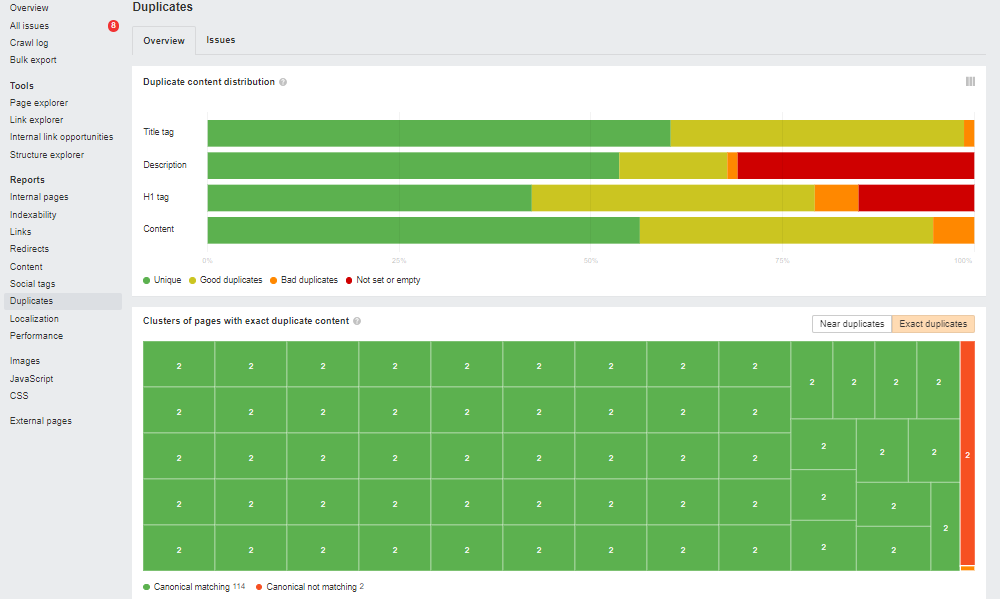
Resolve these as quickly as possible to avoid bogging down your drug rehab SEO.
6. On-Page Optimization
On-page SEO focuses on implementing your focus keyword into meta titles, headlines, subcategories, and everywhere else that counts.
The first thing you should do (if you’re using the WordPress CMS) is to visit the WordPress Plugin Directory and download your favorite SEO plugin. I recommend Yoast, All in One SEO Pack, SEO Press, or my favorite: WP Meta SEO.
Free versions of these plugins are adequate for on-site optimization.
For this exercise, we’ll be using Yoast (just because it’s very popular and widely used).
Head over to your WordPress Dashboard ‘Plugin’ section → click on “Add New” → and select “Install Now.” Once that’s done, activate the plugin.

Navigate to any blog post or page you want to optimize.
Scroll to the bottom of the page until you see the Yoast SEO box (called ‘Snippet Preview’). This is where you add your meta title, meta description, and slug:
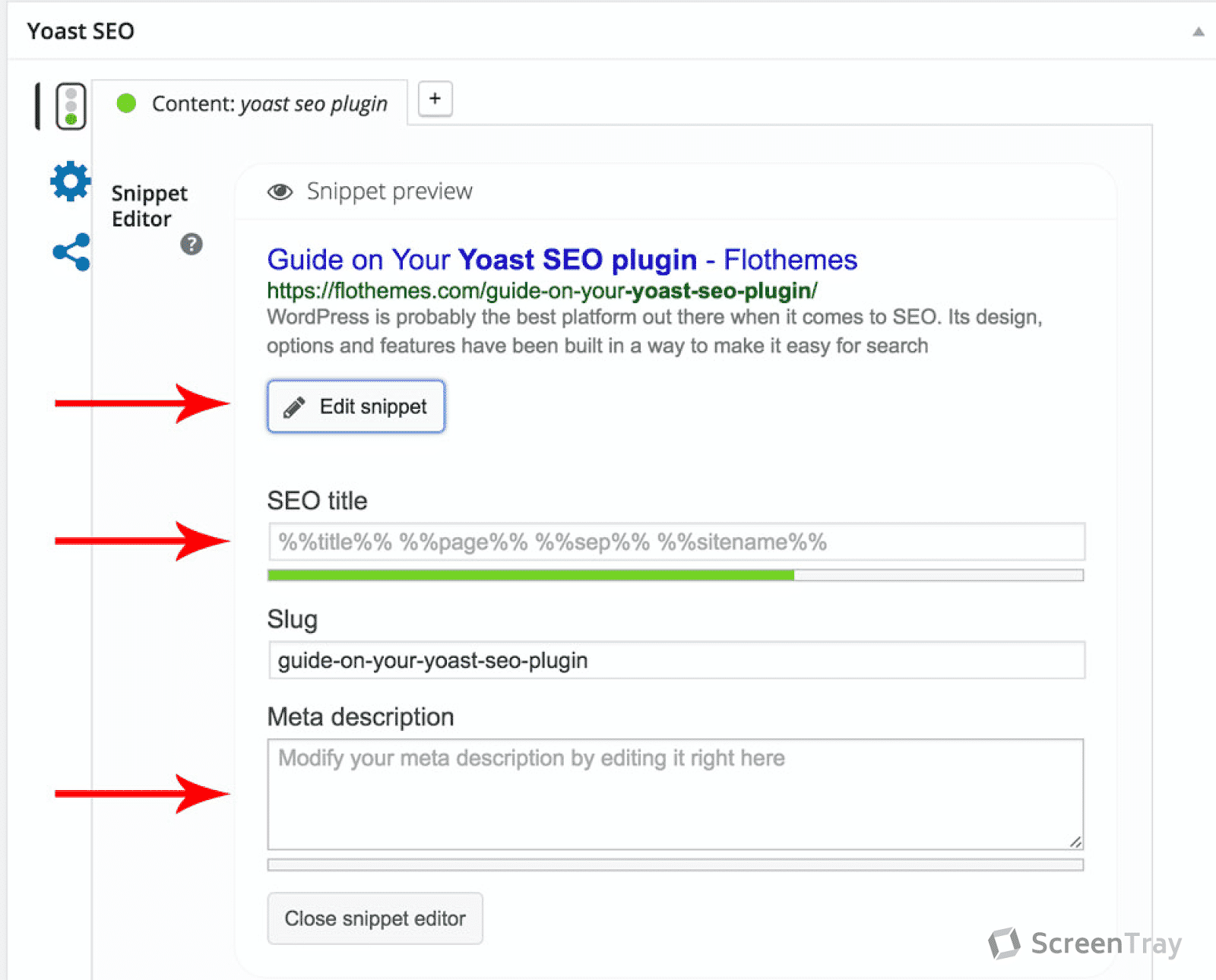
Meta Title
When it comes to writing your meta titles, there are ONLY three things you need to consider:
- Focus keyword (or primary keyword)
- Keyword combinations
- Power words
By adding the focus keyword, you are telling Google what your content is about and giving your potential audience a peek.

You can also use keyword combinations to get better outcomes.
Think along the lines of:
- [Las Vegas Drug Rehab]
- [Las Vegas Drug Rehab Center]
- [Drug Rehab Center in Las Vegas]
- [Effective Drug Rehab Center]
- [Personalized Drug Rehab Program]
Finally, I recommend adding things like numbers, text in brackets, colorful language, or text that stands out.
The goal is to visually attract AND evoke curiosity so your headline can stand out from the crowd and get more clicks.
Meta Description
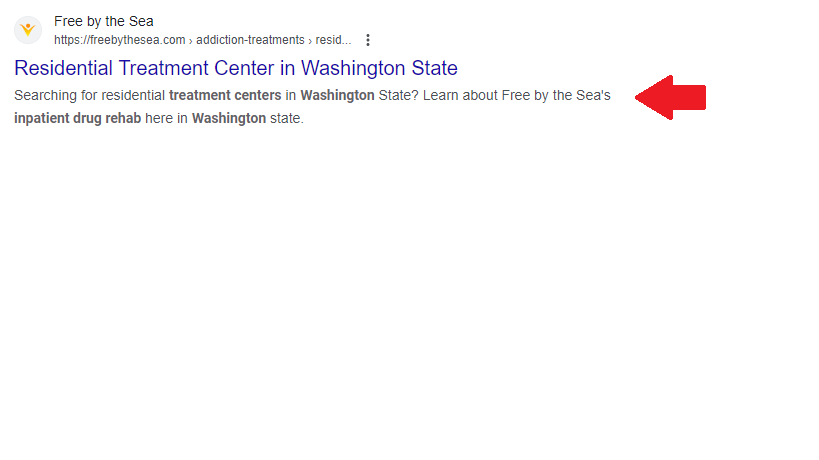
This provides a general description of your page and is a major driver of traffic.
Some pointers:
- Don’t write more than 155 characters.
- Use your focus keyword at least once.
- Use a call to action to invite readers to click through.
Don’t want to write meta descriptions completely by yourself?
You could always use AI to make short work of the process.
Both Jasper and Yoast SEO AI have plugins for WordPress. These can help you save time and effort — but don’t forget the necessary quality control.
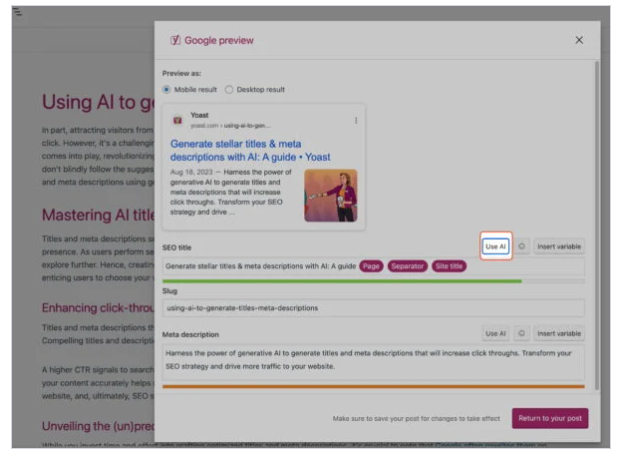
URL Optimization
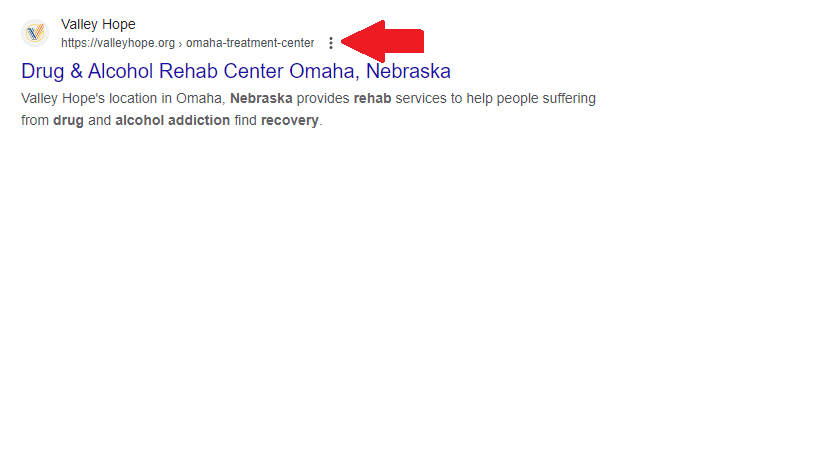
URL slugs may not matter much to people, but they do matter a lot to search engine bots.
I do the following for my clients:
- Remove numbers and dates to avoid aging the content (or at least update them regularly)
- Add the focus keyword if possible
- Keep everything short and sweet
If you do all of the above for all your web pages, you’ll be an on-page pro in no time.
7. Off-Page Optimization
Off-page optimization involves everything you do outside of your site to boost your search engine rankings. This includes social media marketing, forum posting, and podcast appearances.
It also includes link building, but I’ll touch on that later in the guide.
Let’s eat the elephant one bite at a time.
Social Media Marketing
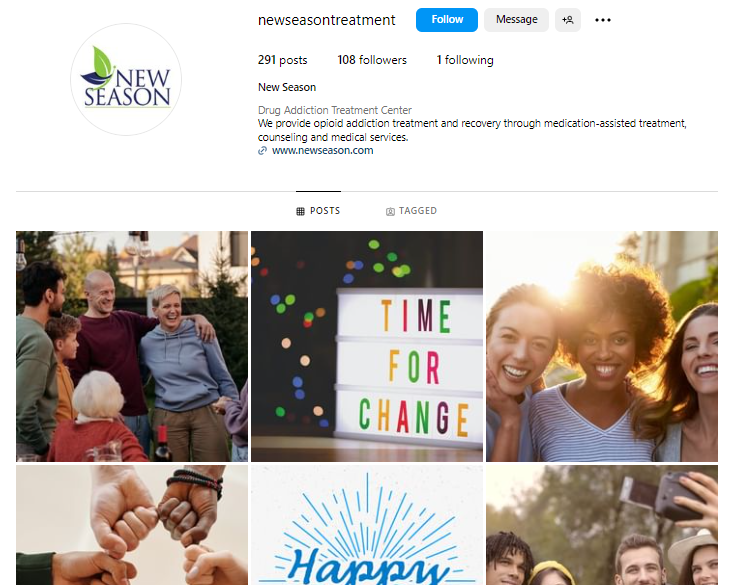
Social media marketing proves your addiction treatment center is a real and trustworthy business.
It can also attract natural mentions of your brand, which is good social proof for both people and robots.
I recommend creating social media accounts if you don’t already have them. No need to create an account for every platform — just a primary two or three.
For addiction treatment centers, this usually includes:
- X (formerly Twitter)
Just please, please be ethical about this.
If you’re not sure where to get started, tools like Jasper and ChatGPT can help. You can use the prompt below to brainstorm your own content calendar:
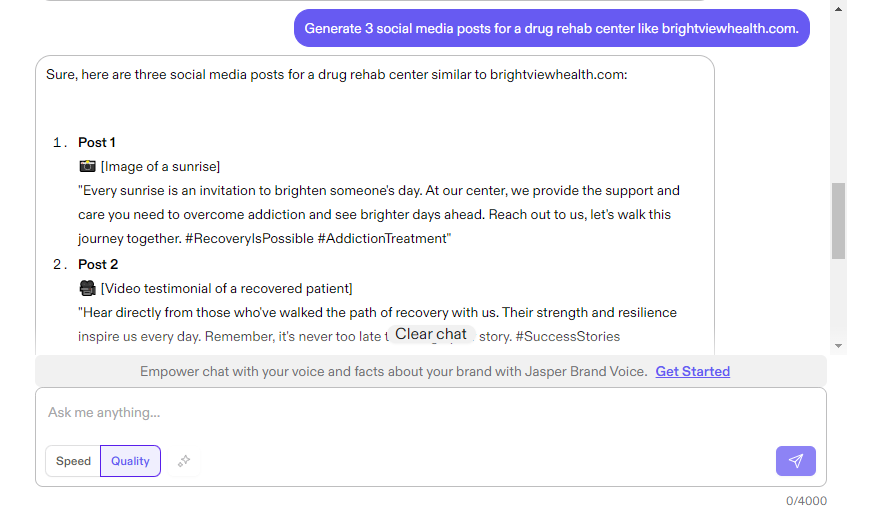
Forum Posting
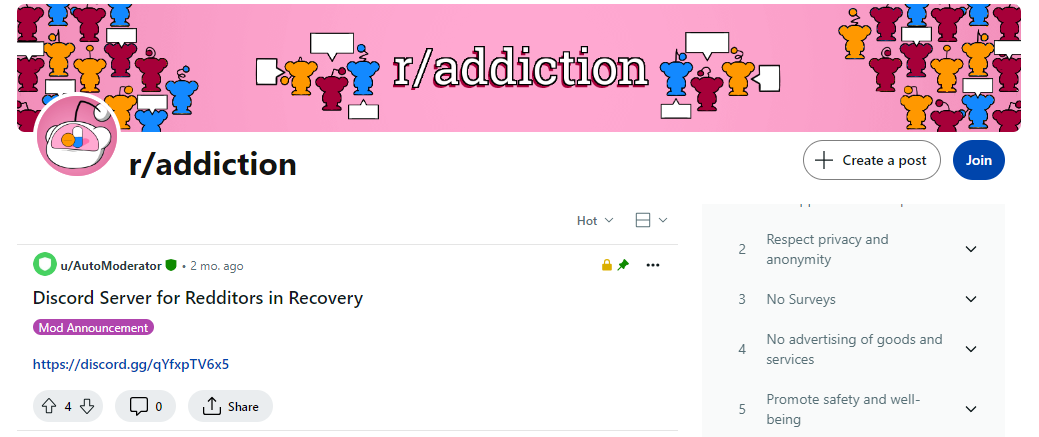
Forums allow you to demonstrate industry authority while engaging in a niche community.
Reddit, Quora, and certain Facebook groups are a few examples.
For off-page SEO, you could:
- Share some of your content should you feel it’s legitimately helpful to the community
- Create AMAs where forum users can ask specific questions about your niche
- Asking questions to generate community discussion (such as ‘who was your greatest champion on the road to recovery?’)
Since platforms like Reddit and Quora surged to the top of Google results after the Helpful Content Update, establishing a natural presence may not be a bad idea.
Just remember to take it easy on the hard advertising. Many forums don’t allow it, and worse, it could make you look particularly salesy or uncaring.
Podcast Appearances
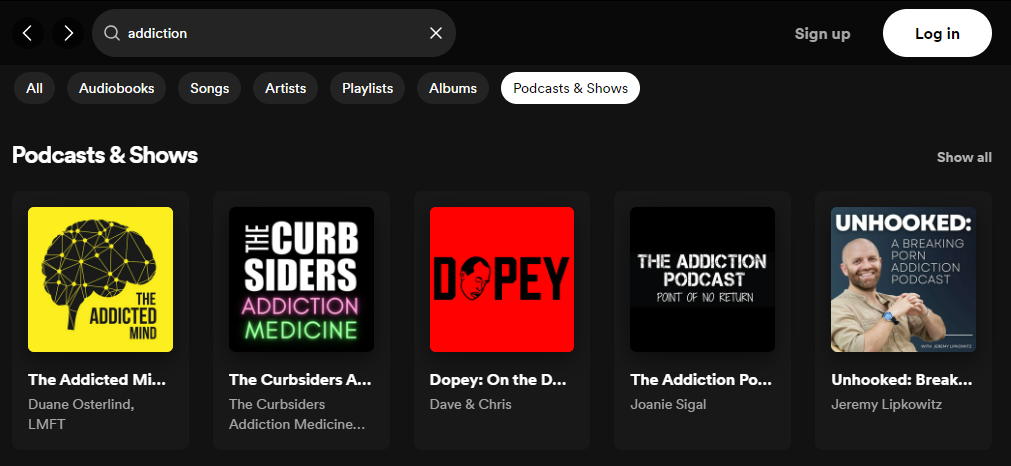
Like posting on forums and social media, building a podcast presence isn’t a bad idea for getting your name out in the community. It’s also a decent way to build a few backlinks, depending on how the podcast credits your treatment center.
Podcast Hawk is an excellent way to find relevant podcasts in your drug rehab center niche.
You could even start a podcast of your own. But be warned: this may take more time, money, and effort than you’re willing to budget for right now.
Just start with a few podcast appearances and move into new opportunities from there.
8. Page Speed Optimization

The faster your website loads, the higher your rankings will be.
It may not have a strong impact 100% of the time, but it does have a huge impact on user experience (which I’m covering later on).
You can check your current page speed with a free test like Pingdom. Just enter the URL of your homepage and hit ‘start test’ to generate results.
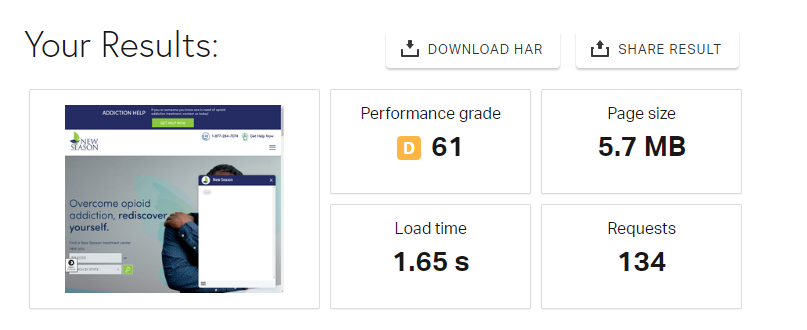
These results for New Season Treatment Center look a little low. Looks like Pingdom has a few suggestions to boost their load time:

Just keep in mind both desktop and mobile searches require optimization. If you’ve only optimized your page speed for desktop users, now is the time to focus on mobile users.
9. Link Building
Link building involves getting other websites to link to your website (or a page therein). The more quality links you have, the higher your domain authority will be.
And the higher your domain authority is, the more likely it is you outrank your competitors.
I’ve tested more than 50 different link-building techniques over the years. But I ended up with just a handful I’d recommend for drug rehab SEO.
These include:
- Guest Blogging
- Sponsored Link-Building
- Footer Or Sidebar Links
- Buying Links
- Competitor Links
Again, natural link-building is not a technique — it is an outcome of your efforts. Be prepared to spend weeks and months building backlinks for your treatment center.
Guest Blogging
This involves writing a guest blog for a website within your niche. Since most websites allow for one or two backlinks, it’s a great way to boost your site’s DA.
Here are my suggestions:
- When someone contacts you about guest blogging opportunities, ask them to send over the full list of their guest posts. These are great guest-blogging opportunities because you can contact these sites to see if they would accept a guest post from you, too.
- Google industry keywords and add ‘write-for-us’ at the end (i.e., “rehab” +write-for-us). This is an amazing way to find sites that happily accept guest posts.
- Copy/paste your competitor’s URL into a backlink checker tool and look for backlinks from blogs. There are two backlink checker tools I recommend — SEO Review Tools and Linkody.
Here’s an example template you can use to reach out about guest posting opportunities:
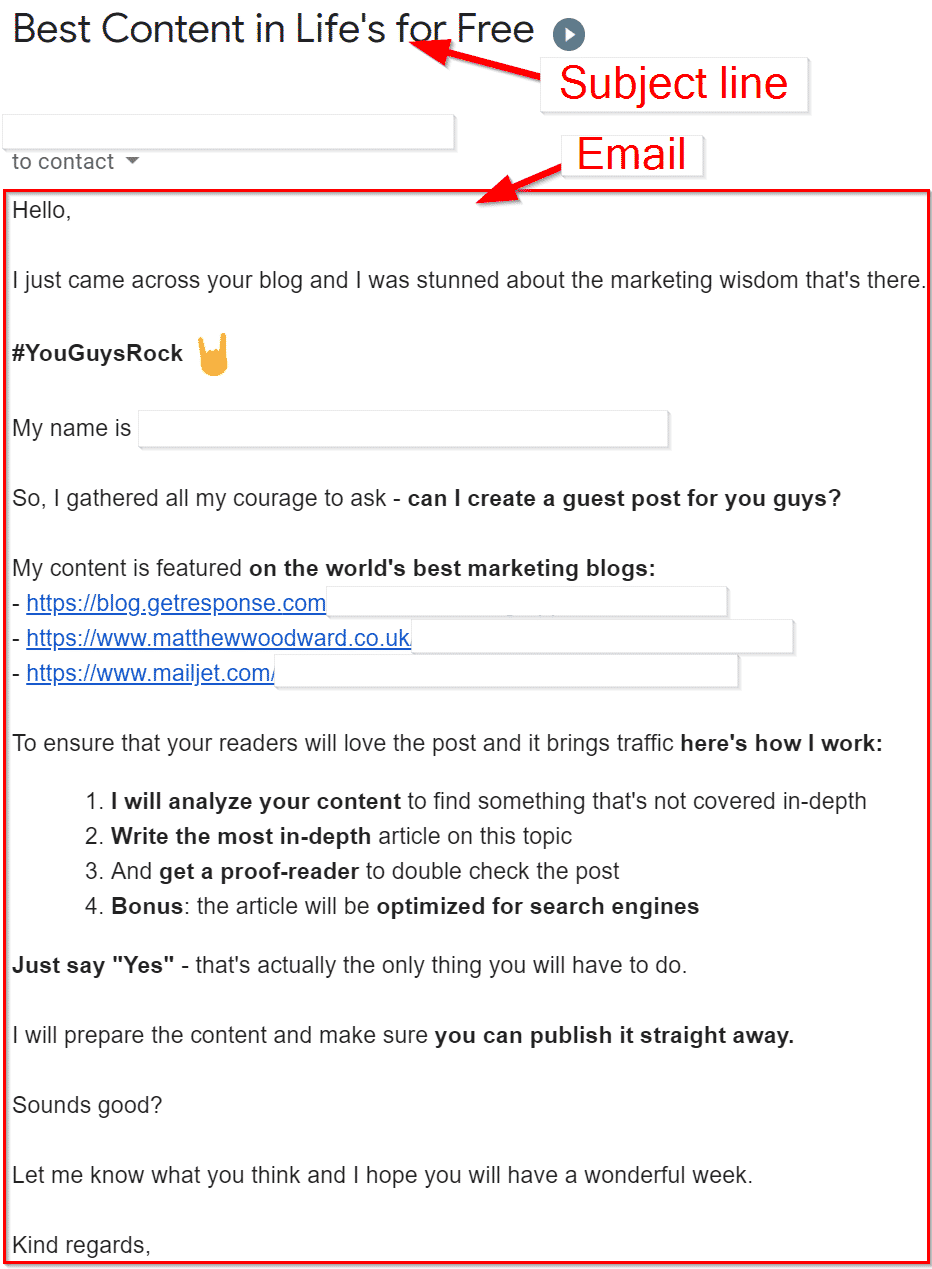
Sponsored Link-Building
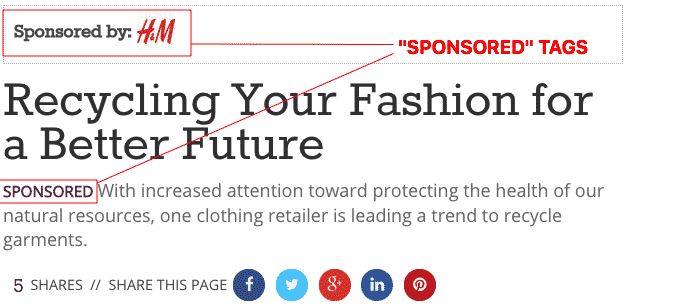
This link-building method is the most ethical way to promote your own digital content.
The website you pick includes your post as a ‘paid placement’ or ‘sponsored post,’ informing readers you have paid for the placement of your brand.
To discover websites in your niche providing sponsored content services, use Google to search for opportunities (including the word “advertise” in brackets).
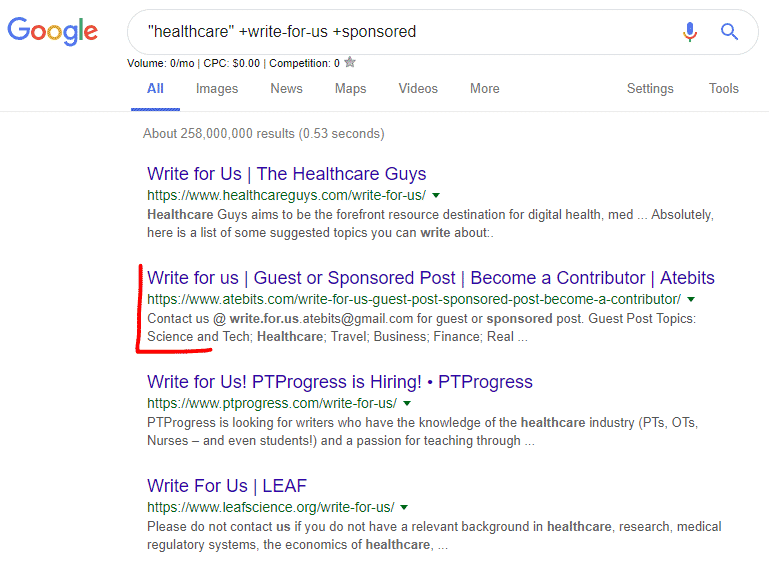
Once you organize your favorites in an Excel sheet, you can contact them in order to discuss the possibilities of sponsored post placements.
Below is a template you can use for your outreach strategy:
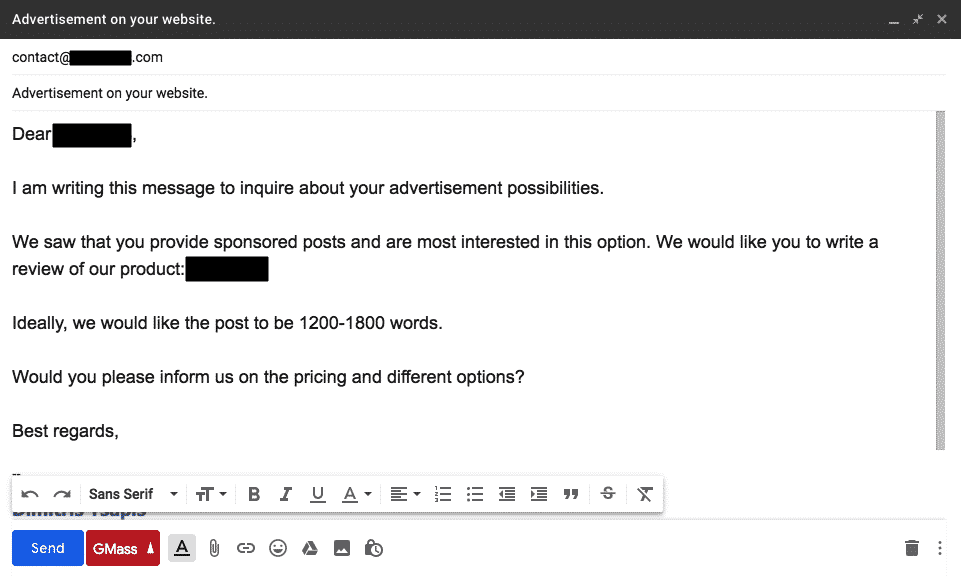
Footer Or Sidebar Links
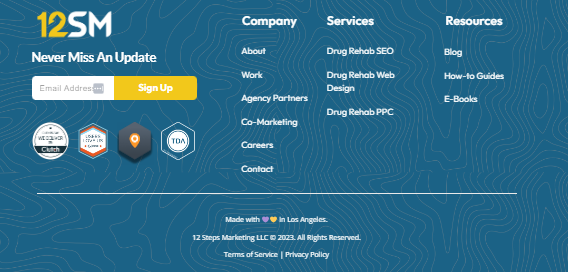
You can see an example of footer links by scrolling to the bottom of our website.
Our service pages target specific keywords in the footer, which is present on every page of our site.
Here are my suggestions:
- The best way to find opportunities for footer backlinks is to ask your existing clients or partners to place your backlink on their website. The majority of people looking to add a footer backlink include web designers, software developers, and sometimes SEO experts.
- The best way to find opportunities for sidebar backlinks is to look for an article that is relevant to your website or content. You can always reach out via email and ask for a backlink. Since sidebar links are sitewide, they will be presented on every page of the website, increasing your total number of backlinks.
I personally think using your website to sculpt SEO authority is 100% ethical and white hat. Just don’t overdo it with hundreds of sitewide footer links from private networks or spammy domains.
Buying Links
Even with all the fearmongering and scare tactics by Google, it is nearly impossible to algorithmically detect a link you paid for versus a link you got naturally.
That being said, don’t spend your entire marketing budget on a link-shopping spree.
You should consider buying:
- Links from relevant industry domains
- Links from domains with high-traffic
You should never consider buying:
- Links from private blog networks (unless you make your own)
- Links from domains with low-traffic
I personally think websites with higher organic traffic are worth more than those with high domain authority. Plus, the links you buy can potentially send ‘referral traffic’ to your website. It is a win-win scenario.
Competitor Links
Even if you’re late to the game, it’s possible to surpass your competitors with better content and a well-timed email.
You can easily ‘steal’ links from your competitors by asking webmasters to replace old content with your newer, better version.
This is pretty straightforward:
- Find a keyword you want to rank for
- Look for the top articles that are ranking for the keyword
- Build a shortlist of 10-20 articles
- Use an SEO tool to find domains that link to these articles
- Create content that is 10x better than what is currently out there, or create content that complements the originals
- Collect the contact information of the domain where the article is published, as well as domains that link to the articles
- Get busy with outreach
- Ask the webmasters to replace the old article link with your 10x better content
If you want to automate this process, you can use NinjaOutreach to automatically search and find webmaster email addresses. You can then customize an email template so you don’t have to manually message every contact on your list.

10. User Experience
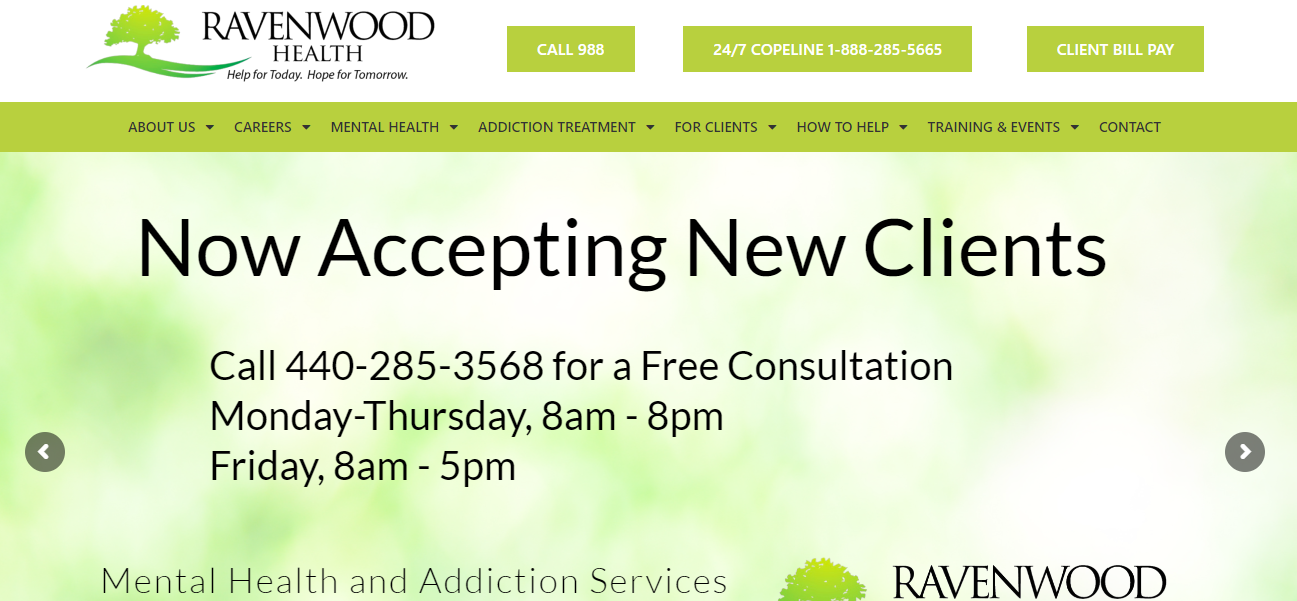
UX and SEO are two sides of the same coin.
SEO brings users to your website. UX engages them so they stay.
I realize not every website has the time or money to invest in cutting-edge UX. However, a few quality-of-life updates could go a long way, especially for patients or family members looking for information fast.
I recommend:
- Clarifying your call to action (CTAs). No fluff or beating about the bush.
- Ensure users have a safe browsing experience. HTTPS is a must.
- Make your website as accessible as possible. You can skim through the W3C Accessibility Guidelines for ideas.
Remember: the digital-first healthcare consumer has high expectations for addiction treatment centers. If you don’t immediately provide what they need, they will quickly move on to a competitor.
11. Tracking and Analytics
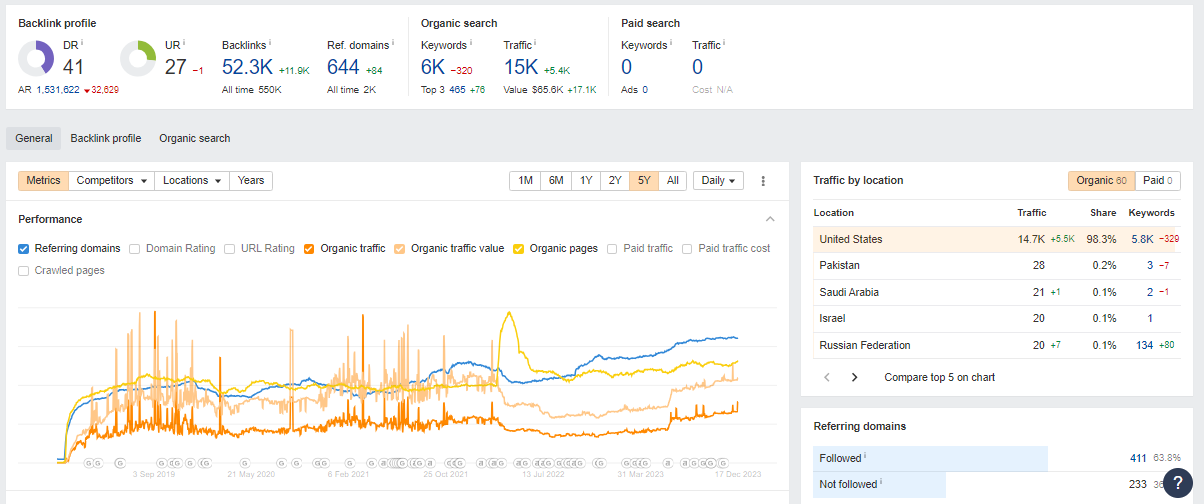
You made it to the last step — congratulations!
As you probably expected, it involves tracking and measuring the impact of your SEO strategy.
A few tools I recommend (if you’re not already using them) are:
- Ahrefs
- SEMrush
- Google Analytics
There are tons of tutorials out there for using each of these tools. But if you don’t feel confident or are worried about missing something, you can always work with an SEO agency like 12SM.
SEO Process
SEO is a journey rather than a destination.
You can’t expect to start ranking overnight.
And you aren’t going to stay ranked unless you constantly build your equity.
My advice is to follow the seven steps of the SEO process:
Discovery
This includes uncovering anything you need to know about your business, target personas, and ultimate goals.
This is also the stage where you should:
- Audit your website
- Perform competitor analysis
- Delegate (or do) keyword research
- Get a benchmark of your current standing
Strategies
This stage combines multiple strategies into a practical and actionable framework. If you’re working with a drug rehab SEO agency, no worries — they’re going to do this part for you.
Strategies typically include:
- Speed optimization updates
- Content marketing suggestions
- Target keywords
- Link building opportunities
- Technical SEO considerations
- On-page or off-page work
Implement
Exactly what you think it means — you (or the SEO agency) puts your strategy into motion.
Some strategies take longer than others, like backlinking for example. But you should still start to see progress within the first three months or so.
Optimize
The optimization stage is the halfway point of the process, meaning you’ve implemented your strategy and are now working on fine-tuning.
Some examples of this include:
- A/B testing
- Adding a content bucket
- Performing content refreshes
- Writing location pages for local SEO
Analyze
You or your agency reviews your organic search performance to get a better idea of how the strategy is working. This usually requires the help of SEMrush or Ahrefs, as well as Google Analytics to verify site traffic.
Audit
Regular SEO audits ensure you’re never wasting time focusing on solutions that don’t work for your rehab center.
It also holds your SEO agency accountable. A good company never keeps your team in the dark about numbers.
Rinse/Repeat
The cycle continues again with new strategies and implementations.
And since Google releases hundreds of updates per year, the approach is likely to change over time.
You can’t expect to see sunny skies for the entire SEO process. But any drug rehab SEO agency worth its salt can help you stay ahead of the curve.
Let’s Look at an SEO Case Study
I get it: all of the above looks like a massive wall of text.
And sometimes it’s easier to put two-and-two together when you have an example to follow.
Let’s look at the example of Bright Future Recovery, a treatment center offering drug and alcohol detox programs and treatment planning for long-term addiction.
Bright Future came to 12SM Agency to get more leads and admissions into their center. To do this, they needed to focus on local SEO so they could spend more time running rather than marketing their business. But they also wanted more transparency into how their SEO efforts measured up.
We built a strategy around hyperlocal SEO and helpful content to aim for first page rankings.
We saw massive results in just 100 days.
After implementing the strategies discussed above, Bright Future Recovery received:
- +16,200 average monthly non-branded traffic
- +400% more first-page Google rankings
- +12,300 keywords ranked
- $46,100 organic traffic cost
Here’s an example of some first-position organic keywords:
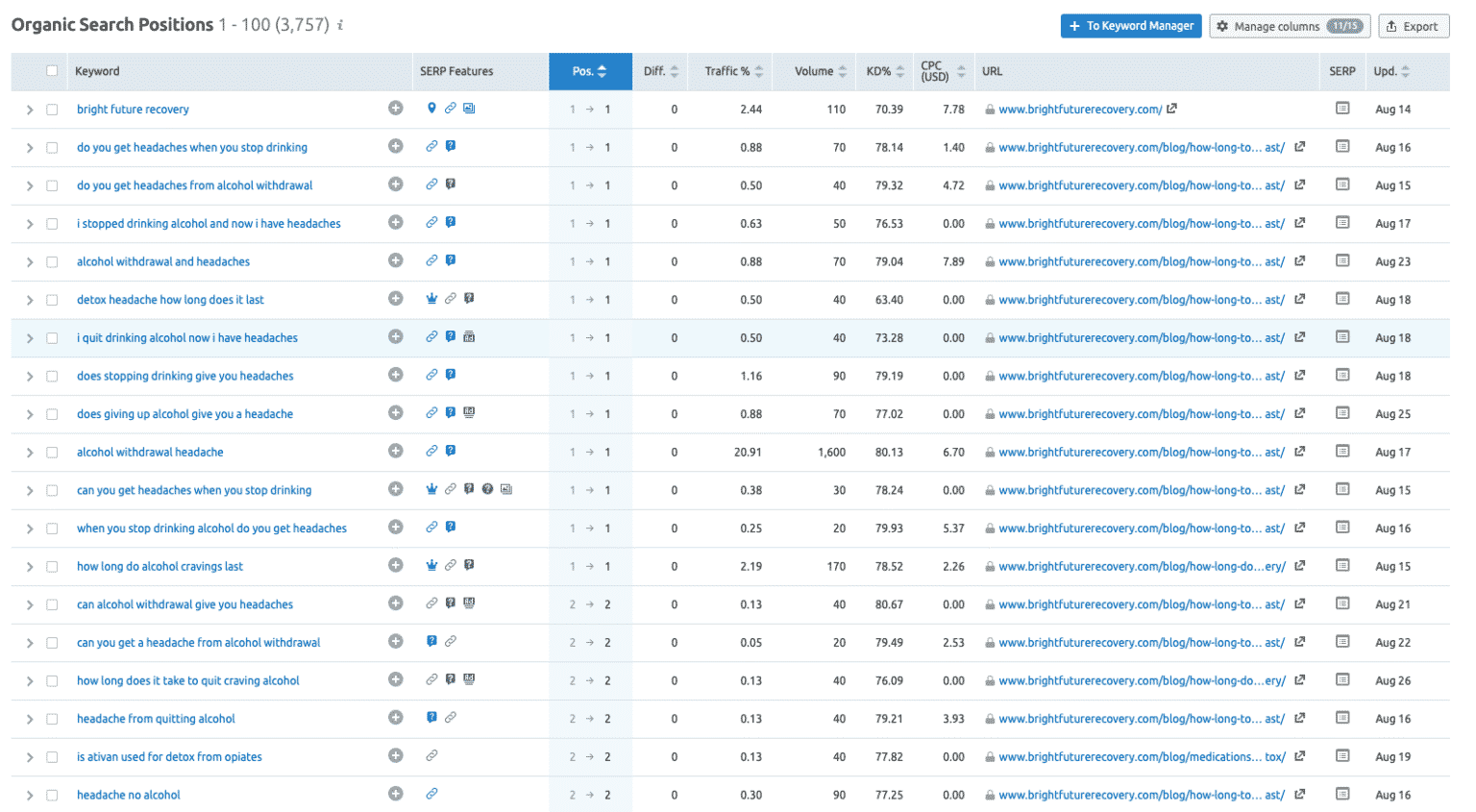
How to Find The Right SEO Agency Partner
Your drug rehab center’s census won’t magically skyrocket just by reading this guide. You also need to act by applying and testing these actionable SEO tips.
If you don’t have time to implement SEO steps on your own, you can look for an agency partner to do so at scale.
But not all SEO agencies are built alike. As you cross names off your shortlist, it may get harder and harder to choose the right one.
How do you pick the right agency partner? I recommend asking these three questions:
Are Their Reviews Good?
Reviews matter, especially when it comes to SEO agencies.
There’s a lot of agency ‘performance-washing’ out there, meaning they’ll say or do anything just to keep you on retainer.
Customer reviews cut straight through the noise. Not only can you identify patterns, but you can also get a glimpse of what it’s like to work with a specific company.
I’m happy to say 12SM Agency has gathered quite a few positive reviews over the years.

We’re also upfront about what you can expect: clients get results in just 100 days.
Are They A Specialist In Your Niche?
What works for a lawn care company or a retail store probably isn’t going to work for a drug rehab center.
You know that. I know that.
But not all SEO companies do.
12SM Agency specifically focuses on addiction treatment centers. This means we don’t lump you in with other industries or take the same boilerplate approach to every client.
We happily apply our knowledge of the industry to your specific business model. We’ve spent years helping treatment centers make a difference for patients in their community.
This leads directly to my next point…
Do They Have Case Studies To Share?
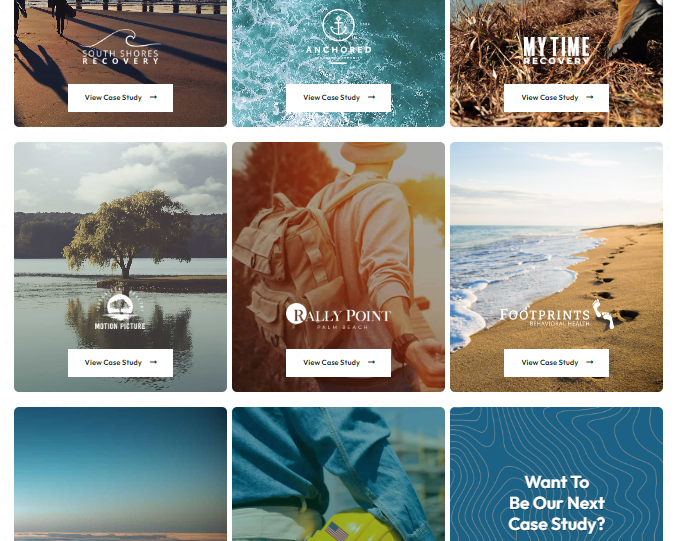
The best SEO agencies for drug rehab centers aren’t cagey about their successes.
Because they don’t need to fake it ‘til they make it.
They can prove their technique with real numbers.
At 12SM Agency, we collect and share authentic case studies from the many addiction treatment centers we serve. You can browse our results at any time, or give us a call if you want more specifics.
The Bottom Line On Drug Rehab SEO
And with that, I conclude this mega roundup for drug rehab centers looking to build their SEO.
Kudos to you for making it through the entire article.
The only thing you need to do now is take action. Get out there and try out one or all of the techniques or tips. Let me know how it turns out, or if you have any questions along the way.
But again, please understand search engine optimization never truly ‘ends.’ Don’t expect to do this once and stay on page one forever. Google is always updating its algorithm, after all.
If you have any questions about the tips mentioned in the article, please leave a comment below, and I’ll do my best to answer promptly.
If you’re interested in partnering with 12SM Agency, you can apply to work with us online.

